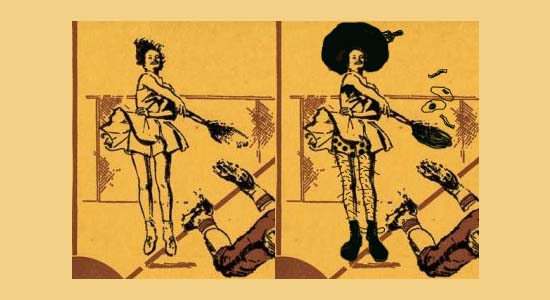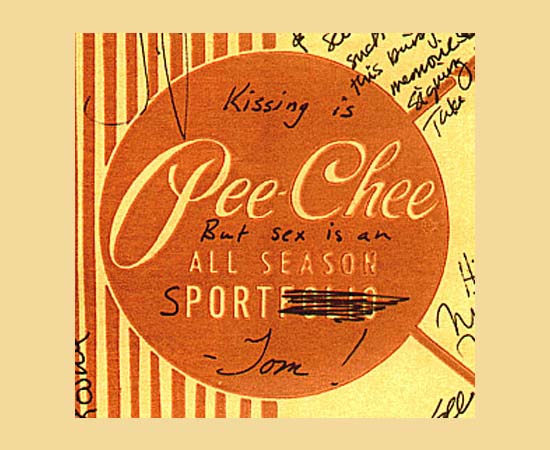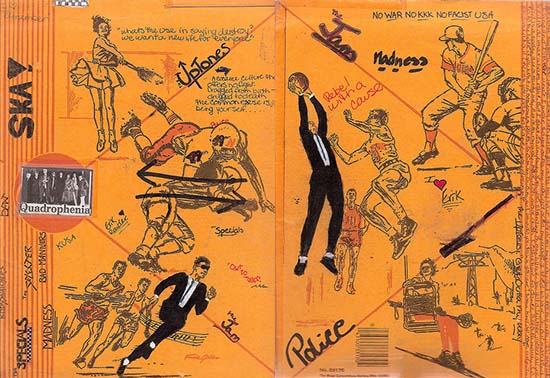The Pee-Chee Folder: Illustrated by the Most Interesting Man in the World
Illustrator Francis Golden could barely remember the project that became an iconic school supply
![]()

A Pee-Chee folder art hack—afros, hairy legs, and frying eggs (image: Greg Narvas, Flickr)
Growing up in Denver, I called sugary, carbonated beverages “pop.” When I moved to California for college and all the coastal kids called it “soda,” I realized just how much geography defines even the most quotidien bits of our lives (I now call it “soda,” too.). I had that realization all over again recently while reminiscing about Pee-Chee folders, encountering a completely blank stare from a New York-native friend who had never heard of them. And here I’d thought the pulpy paper pockets had been a part of every American’s back-to-school memories.
Naturally, I had to look into the history of the Pee-Chee, which as far as I could recall had come in just one color and design. Of course, the school supply aisle was probably as diverse a few decades ago as it is today, lined with Trapper Keepers of a thousand neon faces. But somehow the Pee-Chee wasn’t left behind in favor of flashier options—probably because kids knew that hacking the face of their folder themselves was a far superior personal statement to choosing between the plastic unicorn binder and the plastic race car binder.

Modifying the message on a Pee-Chee folder (image: Greg Navas, Flickr)
In case you grew up outside of Pee-Chee territory, the folder was, as you might guess, peachy-yellow in color, with vertical side pockets on the interior rather than the more common horizontal pocket at the base. The inside contained multiplication tables and other practical reference charts for students. The outside was adorned with line drawings of young people playing sports. The illustrations are iconic (to those in the know), yet pretty boring. In fact, even the man who drew them, Frances Golden, sounds like he was bored when he executed the project back in 1964 (the very first Pee-Chee folder was released in 1943 but it was Golden’s cover design that became best known).
Golden was interviewed for an article in the Spokane Chronicle in 1989, when he was 73 years old. According to the author, the artist “had to be reminded what a Pee Chee is.” After having his memory jogged, he remarked simply, “‘When I look back, it was rather insignificant…It was probably a rush job, I did it over a weekend or some night and that was it.’”
While Golden did commercial work throughout his career, his watercolor paintings were at the center of his own identity as an artist. His portrayals of sport fishing, hunting, and wildlife donned the pages of Collier’s, Sports Illustrated, Audubon, and the covers of L.L. Bean and J.C. Penney catalogs. Indeed, reading Golden’s biography at the gallery that now represents his work elucidates just how little his commercial illustrations meant to him compared to his painting. “e was highly respected as a wild life and sporting scene painter probably because with enthusiasm and gusto he painted what he knew with competence and virility,” says the biography. He was named one of the 12 best outdoor artists in the nation by Sports Afield. In 1939, according to his biography, he painted the background on Salvador Dali’s Dream of Venus pavilion for the World’s Fair in New York City. Golden is (or was—I have been unable to verify whether he’s still living) also ”a tenor in a barbershop quartet, bakes apples pies gourmets envy and is considered ‘a macho Renaissance man’ by those who know him well.”

A Pee-Chee dyptych, by Rain Jokinen (image: Rain Jokinen)
And yet, or those of us who do not know him well, Golden is the man who, 48 years ago, doodled the coed athletes on top of which millions of students would doodle inappropriate appendages, death metal band names, and screeds against substitute teachers. And while not every American kid had one in their school days, the retro fetishism that exists for Pee-Chees today has turned the folder into a nostalgia object even for those who missed it the first time around. Just check out this vintage-inspired swag for Zooey Deschanel and Matt Ward’s indie duo She & Him. And this Patrick Martinez art piece-cum-tee shirt design for Upper Playground (scroll down).
These days, Mead Corporation sells the folders in five colors, and has tried to move away from the confines of peach hues by renaming the product “Color Talk Pee-Chee Folder.” But as of this writing, the version closest to the original is the only one that’s sold out on the Mead site. Because it’s hard to see blue Bic ink on teal or raspberry cardboard. And that’s the whole point.
/https://tf-cmsv2-smithsonianmag-media.s3.amazonaws.com/accounts/headshot/sarah-rich-240.jpg)
/https://tf-cmsv2-smithsonianmag-media.s3.amazonaws.com/accounts/headshot/sarah-rich-240.jpg)